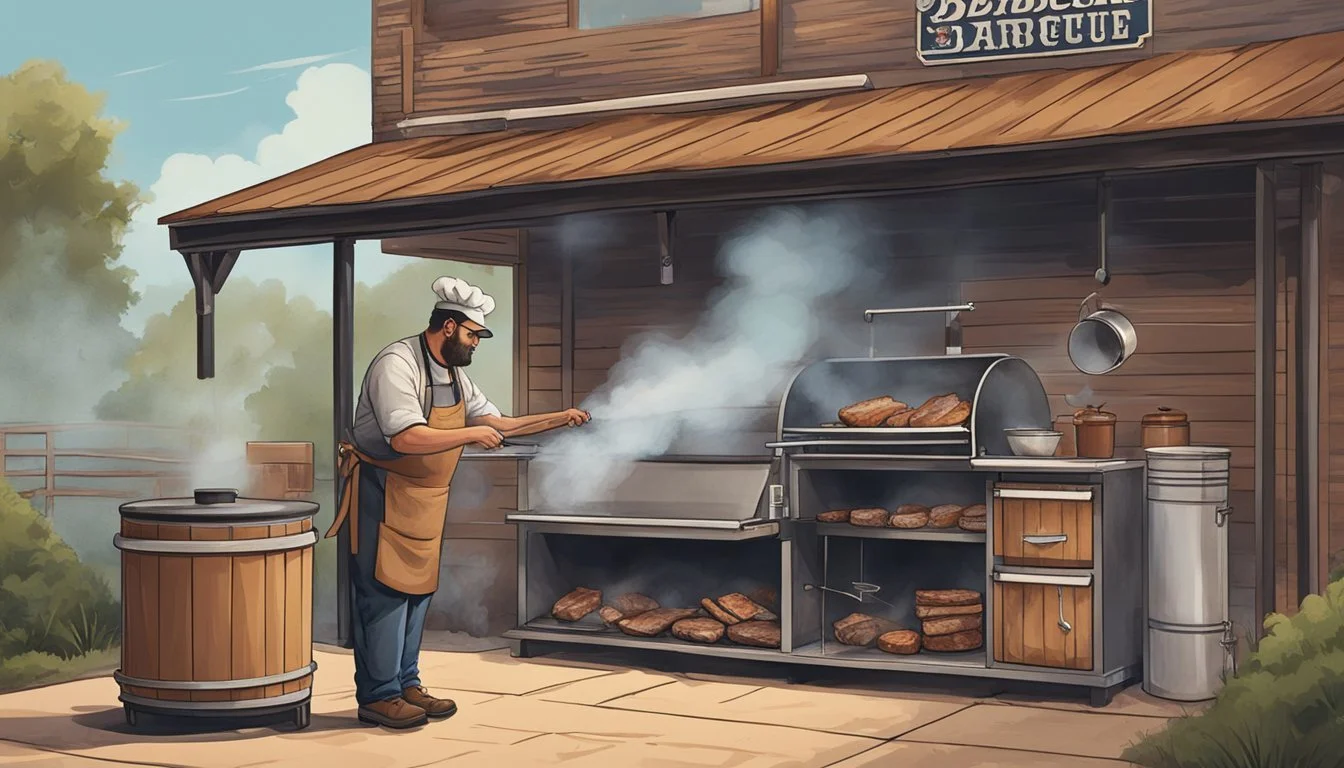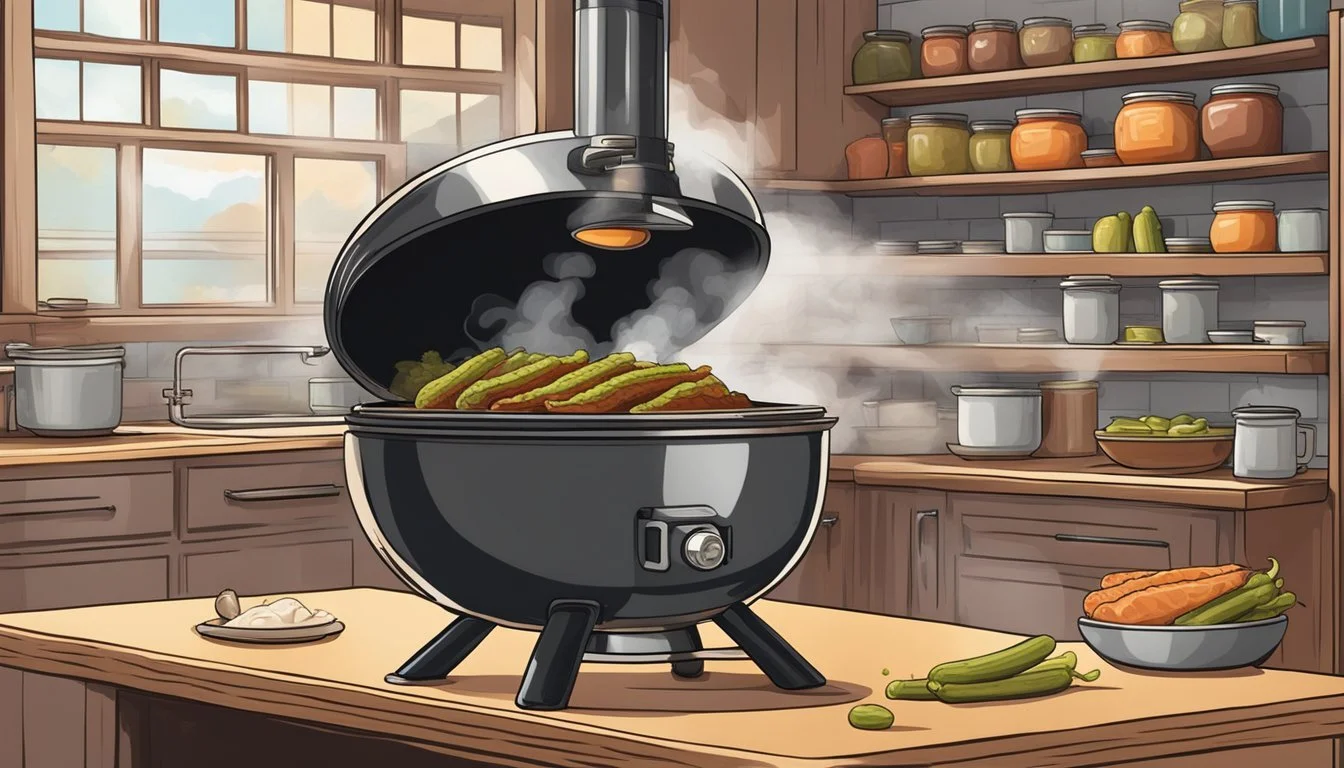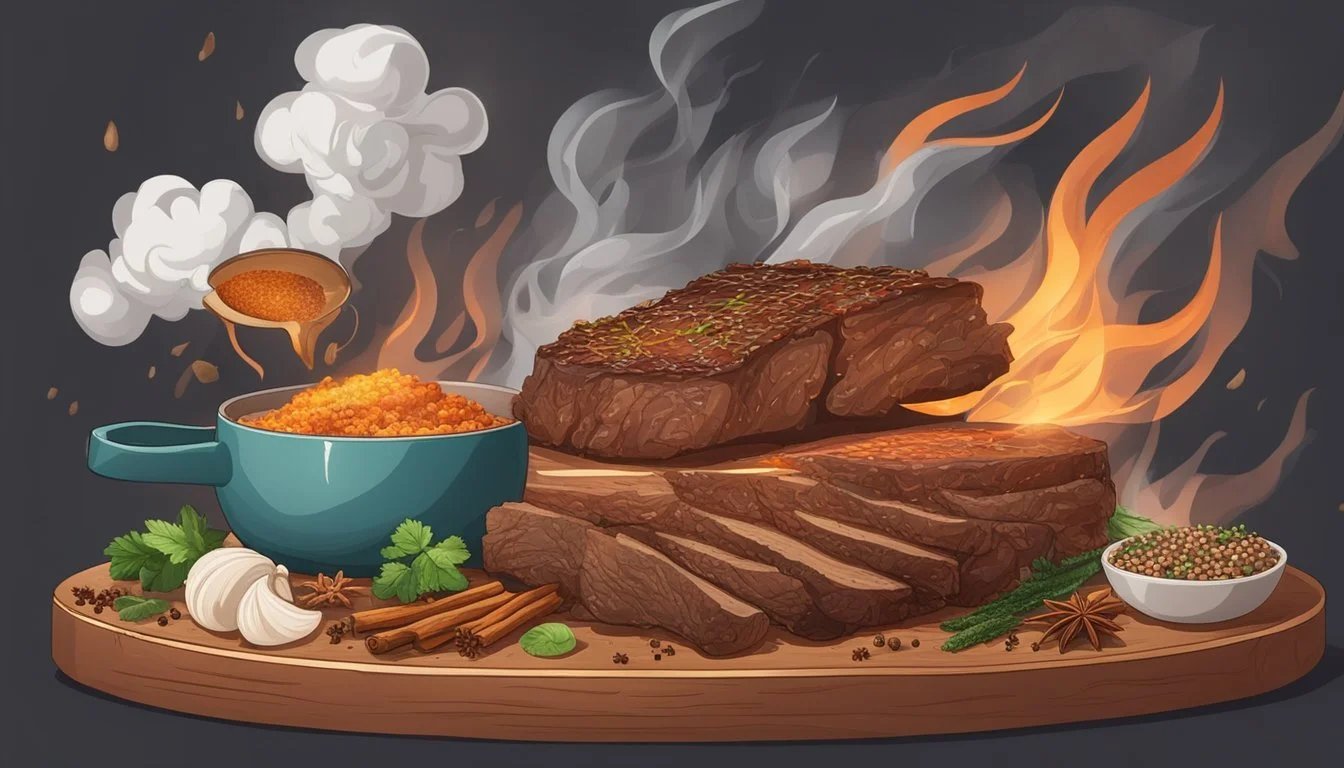The Heart of Texas Barbecue
Brisket Smoking Secrets Unveiled
In the heart of Texas, barbecue (What wine goes well with barbecue?) is not just a method of cooking – it's a tradition steeped in history and regional pride. Central to this culinary art form is the smoked brisket, a cut of beef that demands patience and expertise to perfect. Texas-style brisket smoking is a craft that captures the essence of flavor, transforming a tough piece of meat into a tender, smoky delicacy. This process, revered by barbecue enthusiasts, relies on a low and slow cooking ethos, where the meat is cooked over indirect heat for several hours.
The key to achieving the quintessential Texas brisket lies in the balance of simplicity and precision. Seasonings often consist of nothing more than salt and pepper, sometimes accompanied by garlic or other spices, allowing the natural flavor of the meat to shine. Smoke itself is a crucial ingredient, with the choice of wood – such as oak, hickory, or pecan – imparting subtle nuances to the brisket's flavor profile. Expert pitmasters understand that the wood's smolder must be just right to complement the meat without overwhelming it.
The commitment to maintaining the ideal temperature, typically around 225°F to 250°F, is vital for the brisket's transformation. Cooking times can range from 1½ to 2 hours per pound, requiring continuous attention to the heat source and the meat. This low and slow technique ensures a brisket that is not only flavorful but also boasts a texture that pulls apart effortlessly. As the brisket smokes, a crusty outer layer known as the "bark" forms, sealing in the meat's juices and contributing to the signature taste that has come to define Texas barbecue.
The History and Tradition of Texas Barbecue
Texas barbecue is a revered culinary tradition, deeply ingrained within the state's culture. It is defined by its preference for meats like brisket, unique smoking techniques, and the regional variations that contribute to its rich history.
Origins of the Texas Brisket
Texas brisket smoking can trace its roots to the early 19th century, with significant influence from German and Czech immigrants who brought their smoking techniques to Central Texas. The smoking of brisket was popularized due to its ability to transform tougher cuts of meat into tender plates of barbecue. In East Texas, the method involved slow cooking the brisket over hickory wood, leading to a juicy, fall-apart texture.
Central Texas: Emphasized on the quality of the meat and simplicity of seasoning, focusing the flavor on the smoking process.
East Texas: Traditionally more of a marinated brisket that's slow-cooked to perfection, allowing the meat to absorb flavors and become incredibly tender.
Influence of Texan Culture on Barbecue
Barbecue in Texas isn't just food but a cultural event that symbolizes Texan pride. It brings communities together and serves as a social centerpiece in local gatherings and family celebrations. Austin, the state's capital, is not only the political heart of Texas but also a vibrant hub for barbecue, blending tradition with innovation.
Tradition: Events and family functions often feature barbecue as the highlight, representing a sense of community.
Austin: Known for its bustling barbecue scene where old-school joints and new innovators showcase their love for Texas brisket through various smoking techniques and flavors.
Selecting the Ideal Brisket
Selecting the ideal brisket is a critical step in achieving the quintessence of Texas barbecue. The choice of brisket impacts flavor, tenderness, and overall quality.
Understanding Brisket Grades
When choosing a brisket, one must consider the USDA grading system. The most common grades are Select, Choice, and Prime. Prime denotes the highest quality with abundant marbling, which contributes significantly to the flavor and juiciness of the meat. Choice grade briskets are more common and offer moderate marbling, while Select grade is leaner and might require more careful cooking to maintain tenderness.
Brisket Anatomy: Flat and Point
A whole brisket, often referred to as a "packer brisket," comprises two distinct parts: the flat and the point. The flat is leaner and more consistent in thickness, ideal for slicing. The point contains more marbling and connective tissue, lending itself well to more succulent, flavorful dishes after longer cooking times. A balanced brisket includes both portions, providing a variety of textures and flavors.
Fat Cap and Marbling Essentials
The fat cap of a brisket, a layer of fat on the top of the brisket, should uniformly measure about 1/4 inch in thickness to impart moisture and flavor while cooking. Optimal marbling, the white flecks of fat within the muscle, is also vital for a tender and flavorful brisket. When at the butcher shop, one should look for a brisket with a creamy white fat cap and noticeable marbling without excess external fat.
Preparation Before Smoking
Before smoking begins, meticulous preparation sets the foundation for the quintessential Texas barbecue brisket. Trimming the brisket to the ideal proportions, creating a well-balanced rub, and deciding whether to inject are critical initial steps that will influence the final product's flavor and texture.
Trimming the Brisket
One begins with a whole "packer" brisket, which includes the flat and the point. They must trim the excess fat to ensure an even thickness across the brisket, optimizing the rendering process and smoke penetration. A general guideline is to leave about 1/4 inch of fat cap on the top. This will maintain moisture while it cooks slowly. Sharp knives and a steady hand are the tools requisites for this task.
The Art of the Rub
The rub is fundamental to achieving the iconic crust and deep flavors synonymous with Texas barbecue. A basic but potent mixture typically includes coarse kosher salt, black pepper, and often garlic powder. It's essential to evenly coat all sides of the brisket for consistent flavor. The rub ratio is often a subject of debate, but a 1:1 ratio of salt to pepper is a common starting point.
Kosher Salt: 50%
Black Pepper: 50%
Garlic (optional): to taste
To Inject or Not to Inject
Injecting the brisket with a liquid solution can enhance both flavor and tenderness. However, in the Texas tradition, it is not a necessity. Those who choose to inject typically do so with a simple solution that might include beef broth or a concoction that complements the rub's flavors. If one opts out, they must rely on the rub and smoking technique to produce a juicy and flavorful brisket.
Smoking Techniques and Equipment
Mastering brisket smoking demands an understanding of your equipment, selecting the appropriate wood, and managing the fire and smoke for optimal flavor.
Understanding Your Smoker
Selecting the right smoker is crucial for Texas-style brisket. Traditional options include offset smokers, where the firebox is separate from the cooking chamber, and pellet smokers, which use compressed wood pellets for both fuel and flavor. The smoker should reach and maintain a consistent temperature range, typically 225°F to 250°F, to ensure even cooking and infusion of smoky flavor.
Choosing the Right Wood
The choice of wood is paramount in imparting the desired flavor to the brisket. Texas barbecue often uses oak, known for its mild and versatile smoke profile. However, woods like hickory, mesquite, and pecan are also popular, each bringing a unique taste:
Oak: Delivers a balanced smokiness, suitable for longer cooks.
Hickory: Strong, bacon-like flavor; use sparingly to avoid overpowering.
Mesquite: Intense and earthy; best for shorter smokes.
Pecan: Sweet and mild; provides a subtle richness.
Managing Fire and Smoke
Effective fire management ensures a steady flow of thin, blue smoke—the hallmark of clean combustion and quality flavor. Avoid thick white smoke, which can leave a bitter taste. Whether using charcoal, gas, or wood itself as fuel, maintaining a consistent temperature is pivotal for that perfect smoky crust and tender interior. Adjust vents and dampers to control oxygen flow, and regularly monitor the temperature, aiming for the sweet spot where the brisket can absorb maximum smoky flavor without drying out.
The Smoking Process Detailed
Smoking a brisket is at the heart of Texas barbecue, a process that demands precision in temperature and time, a mastery of smoke infusion for that coveted smoke ring, and a strategic choice between foil and butcher paper wrapping techniques.
Optimizing Temperature and Time
The journey to tender, flavorful brisket starts with a consistent low temperature, typically between 225°F and 250°F. While too high a temperature can dry out the meat, too low a temperature will increase cooking time unnecessarily. The total cooking time varies, often following the axiom of 1½ to 2 hours per pound of brisket. It's crucial to reach an internal temperature of around 190°F to 203°F, the sweet spot for tenderness.
Smoke Penetration and the Smoke Ring
The essence of the taste lies in the smoke's penetration. Hardwood such as oak or hickory offers the authentic Texas flavor. Achieving a prominent smoke ring, a pink layer beneath the brisket's surface, is a sign of a well-executed smoking process. To facilitate smoking, damp wood can assist in the smoldering and enhance the infusion of smoky flavor.
Wrapping: Foil vs. Butcher Paper
To avoid over-smoking and to lock in moisture, wrapping the brisket is a common practice known as the Texas Crutch. Foil offers a seal that traps in moisture but can soften the bark. On the other hand, butcher paper is breathable, allowing smoke to continue to flavor the meat while also retaining adequate moisture for a desirable bark. Each method has its proponents, but both aim to achieve a tender and juicy brisket.
Post-Smoking: Resting and Slicing
After the brisket is lovingly smoked, the journey to perfect tenderness is not yet complete. Resting and slicing are the critical final steps in ensuring a juicy slice of Texas barbecue.
The Importance of Rest
Resting is essential for a brisket to achieve its peak flavor and moisture. Upon reaching the internal temperature of approximately 195°F, the brisket must be removed from the smoker. It should then rest for a period, typically an hour or longer, to allow the meat's fibers to relax and reabsorb the juices that have migrated outward during smoking. A well-rested brisket not only retains its moisture but also offers a more uniform tenderness when sliced.
Best Practices for Resting Brisket:
Time: at least 1 hour
Temperature Check: 195°F internal temperature before resting
Wrapping: Optional, in aluminum foil or butcher paper
Location: Rest at room temperature or a cooler to retain heat
Slicing Techniques for Maximum Tenderness
Slicing a brisket is not simply a matter of cutting it into pieces; it involves technique and precision. The grain of the meat should be closely observed, as slicing against the grain enhances the meat’s tenderness. Chefs should utilize a sharp knife to make clean cuts without shredding the meat’s surface, further ensuring each slice's structural integrity and succulence.
Key Slicing Tips:
Identify the Grain: Locate the direction of the muscle fibers
Sharp Knife: Always use for precise cuts
Angle: Slight angle while slicing, not perfectly perpendicular
Thickness: About pencil-thickness for slices (around 1/4 inch)
Sections: Separate the flat and point sections if needed due to differing grain directions
Resting and slicing are as much a part of the brisket smoking process as the seasoning and cooking itself. These steps are paramount for moist, tender, and flavorful outcomes.
Serving and Accompaniments
Once the brisket is perfectly smoked, ensuring that it is paired with the right sides and sauces can elevate the barbecue experience to new heights.
Complementing Sides
Coleslaw: A classic coleslaw, with its creamy texture and tangy flavor, balances the richness of the brisket. It’s typically made with shredded cabbage, carrots, and a mayonnaise-based dressing.
Potato Salad: Hearty potato salad is a staple in Texas barbecue. A blend of boiled potatoes, mixed with ingredients like onions, celery, mustard, and mayonnaise, provides a comforting side dish.
Pickles: Pickles offer a sharp and tangy contrast which cuts through the fatty brisket, cleansing the palate between bites.
Sauce: Although some purists prefer brisket without sauce, many enjoy it with a drizzle of sauce. Texas-style barbecue sauce is generally thicker and less sweet, with a balanced flavor that complements the meat without overpowering it.
White Bread: Simple slices of white bread serve as a humble vehicle to enjoy the brisket, allowing for makeshift sandwiches or simply a means to sop up any juices and sauce.
Advanced Tips and Common Mistakes
Mastering brisket smoking involves fine-tuning techniques to manage moisture and achieve the perfect bark, while being aware of steps that can hinder the final quality of the meat.
Controlling Moisture and Dryness
A common mistake in smoking brisket is either drying out the meat or ending up with an excessively fatty product. Controlling moisture starts with selecting the right brisket; it should have a fat cap no thicker than 1/4 inch to ensure proper insulation without leaving the meat greasy. During cooking, maintaining a steady pit temperature around 250°F and using a water pan can help to stabilize the humidity levels, thus preventing dryness.
Correct Fat Orientation: Placing the brisket fat side up allows the fat to naturally baste the meat during the cooking process.
Water Pan: An heat-safe pan filled with water aids in maintaining humidity within the pit, reducing the risk of the brisket drying out.
Steady Temperature: Keep a watchful eye on the smoker's temperature to avoid fluctuations that can cause the meat to dry out or cook unevenly.
The Pitmaster's Finishing Touches
The journey to succulent brisket demands patience and experience; however, even seasoned pitmasters can make errors during the final stages. Wrapping the brisket at the right time is crucial—too early can steam the meat excessively, while too late may result in a tough bark. Resting the meat after cooking allows for the redistribution of juices.
Wrap Appropriately: Opt for butcher paper to wrap the brisket once it reaches an internal temperature of around 160–170°F.
Resting Period: After smoking, let the brisket rest for at least one hour before slicing to retain moisture within the meat.
By observing the brisket's response to heat and moisture, adjusting techniques, and avoiding common missteps, one ensures that each brisket is a testament to the pitmaster's skill and dedication to the craft.
Brisket Variations and Innovations
Texas barbecue is a tradition steeped in history, but innovative pitmasters are constantly experimenting with brisket to elevate its flavors. They do this by exploring diverse flavor profiles and incorporating new elements to the tried-and-true methods.
Exploring Different Flavor Profiles
Pitmasters have long known that their choice of wood can significantly influence the taste of smoked brisket. While traditional Texas-style brisket typically relies on oak or hickory for a robust smoke flavor, some chefs are branching out to fruitwoods like apple or cherry to impart a subtle sweetness to the meat. Experimentation extends to the brisket's seasoning as well; while salt and pepper are staples, spices such as cumin or paprika can add a complex layer to the flavor profile.
Woods:
Oak: Traditional, smoky
Hickory: Strong, bacon-like
Apple: Mild, fruity
Cherry: Mild, sweet
Spices:
Salt: Essential for flavor enhancement
Pepper: Adds heat and depth
Cumin: Earthy, warm tones
Paprika: Sweet or smoky undertones
Barbecue enthusiasts are also exploring the use of marinades and brines, incorporating ingredients like apple cider vinegar to tenderize the brisket and enhance its natural flavors. Such innovations open up a myriad of possibilities for flavor variations, allowing each pitmaster to leave their signature on this iconic dish.
Barbecue Fusion: Incorporating New Elements
Barbecue fusion has emerged as pitmasters intermingle classic Texas brisket techniques with culinary influences from around the world. Some chefs introduce Asian elements into their brisket preparation by using soy-based marinades or glazes that include ingredients such as sesame oil or hoisin sauce. Others might draw inspiration from Latin American cuisines, opting to inject the beef with a tangy adobo or mop it with a zesty chimichurri during the resting phase.
Asian Fusion:
Sesame oil: Nutty and aromatic
Hoisin sauce: Sweet and salty
Adobo: Vinegar-based with spices
Chimichurri: Fresh and herbaceous
These innovations add distinct flavor dimensions to the brisket, creating a taste experience that pushes the boundaries of traditional barbecue while still honoring its roots. As trends continue to evolve, one can expect to see an ever-expanding array of flavors and techniques in the world of Texas barbecue.
Community and Sharing
The Texas barbecue scene is as much about the craft of smoking brisket as it is about fostering a sense of community and sharing the experience. Pitmasters and enthusiasts often turn to social media platforms like Instagram to document their barbecue journeys and exchange tips and recipes.
Documenting the BBQ Experience on Social Media
Instagram has become a staple in the barbecue community for documenting and sharing. Individuals post high-quality photos of their smoking process, glistening cuts of brisket, and the tender, flavorful results of their labors. They may structure their posts like this:
Process: They share images of different stages of the smoking process.
Results: Succulent shots of the final brisket, with a focus on the bark and smoke ring.
Caption space is used to detail specific techniques, types of wood used, and temperatures maintained during the smoke. Comments sections blossom into forums for sharing insights and building relationships among barbecue enthusiasts. Through hashtags like #TexasBBQ and #Brisket, these Instagram posts connect individuals across geographies, creating a virtual smokehouse of communal knowledge.
Conclusion
Mastering the art of Texas-style brisket smoking is within reach for anyone willing to pay attention to detail and invest time in the process. At the heart lies the principle of low and slow cooking, a method that transforms a tough cut into a tender, flavorful delight. The essentials include a steady temperature of 225°F to 250°F, consistent monitoring, and a good understanding of the smoker being used, whether it's fueled by charcoal, wood, or gas.
Patience is a virtue, particularly when cooking Texas BBQ. The goal is to achieve meat that not only falls apart with a gentle tug but also boasts a smoky crust, known as the 'bark', and a pink smoke ring – hallmarks of a well-smoked brisket. Experts often stress the importance of:
Meat Selection: Opt for a brisket with good marbling.
Preparation: Trim the fat cap properly and apply a simple, yet effective rub.
Temperature Management: Keep the smoker at a consistent temperature.
Timing: Expect to smoke the brisket for upwards of 1 hour per pound.
Resting: Allow the brisket to rest for at least 1 hour before slicing to retain juices.
Remember, each brisket is unique, and there's no one-size-fits-all approach. The secrets shared by Texas pitmasters are not just instructions; they are guiding principles that invite barbecue enthusiasts to explore and refine their technique to achieve that perfect brisket. With these points in mind, anyone can embark on a journey to create an authentic Texas barbecue experience that celebrates its storied traditions and flavors.
References
When researching the art of smoking Texas-style brisket, a number of sources provide invaluable insight.
An approach to preheating smokers to an appropriate temperature between 225°F and 250°F is commonly agreed upon as essential.
Experts emphasize the importance of a reliable fuel supply, which can be charcoal, wood, or gas.
Expert Tips:
Guidance often circles around achieving a balance in the brisket's tenderness and flavor.
Consistency in smoking methods is noted as crucial for impressively smoked brisket.
Recipes and Guides:
Optimal brisket sizes are suggested to start from 12 pounds.
The fat cap trimming technique is highlighted as a critical preparation step.
Seasoning Advice:
A mixture of coarse black pepper, kosher salt, and sometimes garlic powder is frequently recommended.
Seasoning should be generously applied over the brisket to enhance flavor.
Each resource offers a unique perspective, yet they all converge on the critical elements that contribute to the perfect Texas brisket. It's the attention to detail, such as the thickness of the fat cap and the careful monitoring of temperature that defines the difference between good and exceptional brisket smoking techniques.







